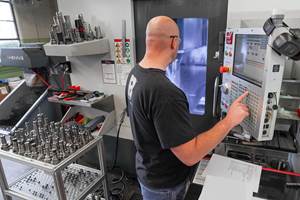Manufacturer Boosts Capacity With Single Setup Production
The Arbor Department at the Gleason Works (Rochester, New York) faced a capacity crunch about a year ago. Despite a process innovation, the crunch has eased but not vanished for this department, where they manufacture arbors, collets, setup gages--in fact, all of the workholding and setup devices for Gleason Works' line of gear processing machines.
The Arbor Department at the Gleason Works (Rochester, New York) faced a capacity crunch about a year ago. Despite a process innovation, the crunch has eased but not vanished for this department, where they manufacture arbors, collets, setup gages--in fact, all of the workholding and setup devices for Gleason Works' line of gear processing machines.
The market for machines to process bevel gears has soared. The largest single market for these gears is in rear-wheel drive vehicles. The "truck" market has mushroomed, particularly since it now includes the very popular recreational pickup truck and sport utility vehicles with four-wheel drive; plus a continuing solid market for larger cars with rear-wheel drives. Another factor in the growth of this business for Gleason is a recently developed full line of CNC bevel gear processing machines with reduced setup times and enhanced flexibility.
Coincidentally, during this period, Gleason strengthened its line of CNC machines for processing parallel-axis (spur and helical) gear processing machines. Three years ago, the Phoenix CNC spur and helical hobbing machine was introduced and became a large seller. A CNC spur and helical grinder quickly followed. Then, with the acquisition of Hurth, a leading German gear machine producer, CNC gear-tooth shaving and honing machines completed the line.
The blessing of increased business brought with it challenges of capacity, backlogs and deliveries. In no department have those problems been more difficult than in the 67-employee Arbor Department. Most jobs are run in lots of three parts or fewer, so setup time is a major factor; it's just not a factor of running machines faster. Products are mostly custom-tailored to adapt the customers' products to the Gleason machines.
Until now, flexibility meant using a series of seven to eight machines, each with a skilled operator. Parts were turned, then milled in one or two setups, laid out for hole locations, and then drilled. "The process necessitated the moving and queuing of parts, multiple fixtures, multiple operators on all three shifts, and despite our best efforts, some tolerance stacking. In fact, when we looked for ways to boost our capacity and throughput, we never considered duplication or even augmenting that sequence," says Charles Menz, facilitator of the Arbor Department.
"We knew that we had to add significantly to our capability, and we had to do it quickly. We searched for a machine that could complete our parts in a single setup, and one that we could get into production in a hurry. We already had a Mazak Integrex 40, so we knew about the machine's multitasking capabilities and about our ability to use it.
"When we found that we could get a larger Integrex 50 built with the additional Y-axis, we bought it. The Y axis lets us complete all operations, including a substantial amount of milling, without removing parts from the machine."
The 40 hp main spindle goes to 3,000 rpm and produces 2270-foot-pound output for turning. The No. 50 taper rotary tool spindle has 15 hp output for secondary milling and drilling operations. Capacity is 27.95" maximum diameter and 40.43" length.
The Integrex 50 has augmented, not replaced, the traditional sequence of operations. Mr. Menz points out that they are still developing the tooling processes and the programs for the machine. In time, it will take an increasing percentage of the work going through the department. For example, on one of those products which are most likely to be repeated with some frequency, it will make more sense to develop the machine programs for them, and then have them available and optimized for the next time.
Mr. Menz explains, "We are programming off line, and then downloading the programs to the machine control. On the first run, the operator and programmer go through the cycle, looking for chances to improve the program and to perfect the cycle. When the job is finished, it will be that optimized program that is stored and ready for next use.
"We know that we can further reduce our cycle times and improve our efficiency on the machine. We are still working our way up on the learning curve."
The programmer, trained at Mazak, is learning about creating the best sequence of operations, cut depths, feeds, and speeds and tool choices (the machine has a 60-tool magazine and automatic tool changer). Two operators, also trained at Mazak, continue to hone their knowledge and skills. And Mr. Menz says that even the persons who work on process routing understand the concept of multitasking and explore all possible capabilities of the Integrex 50 with the Y axis. "Since we produce both rotating and prismatic parts, I challenge them to think `round' first and then prismatic. In most cases, we do the round portion of the workpiece first, and then turn it around in the chuck to finish the other end."
As with most multitasking CNC turning centers, the Integrex 50 has three axes of motion control; the C axis is spindle rotation in the feed mode, the Z axis is parallel with the spindle centerline, and the X axis is the vertical axis perpendicular to the Z axis. In addition, the Integrex has an optional fourth axis (Y) which is perpendicular to the Z axis, but it is horizontal, moving in-and-out across the part. It is the addition of this axis that simplifies the production of prismatic parts by cross feeding for milling or by producing off-center holes, for example. And at Gleason, it is this axis that takes the place of one or more milling and drilling machine operations in the traditional multi-machine production sequence.
In the setup gage, the Y axis mills the large flat and the flange. In the small expander, a saw-type milling cutter mills the grooves. The advantage on this operation is that the cutter does not have to be the same width as the groove, as would be required with an end mill. The cutter makes its first pass down the Z axis: then with a reposition in the Y axis, completes the groove on a return pass. Thus, the bottom of the groove is flat and the two side walls are vertical and perpendicular to the bottom. The same procedure is used to generate keyways and other longitudinal geometry.
According to Mr. Menz, standard procedure is to produce the round portion of the parts in the first operations, and then turn the part around in the chuck to complete the prismatic geometry.
Although, as Mr. Menz says, the department is still ramping up on the learning curve, and although the new machine is producing only a portion of the work in the department, benefits already are becoming obvious. "We are getting more precise parts, because we have virtually eliminated tolerance stackup," he explains.
"We also know that the department used to operate on the basis of a six week lead time. It is now down to four, which would mean that we also have eliminated a third of our work-in-process inventory."
"The same measure applies to the first problem: capacity, up a third."
The department is in transition. "In addition to our continuing improvements in efficiency, we are not finished with our process improvements. We are investigating Pro-Engineering/Pro-Manufacturing, which would permit us to download engineering data directly to the machines. And we have another Integrex in our short term plans."
As is always true, rapid business growth is accompanied by problems, frustration, hard decisions, and too many meetings. But at Gleason, no one seems to mind. MMS
Related Content
Medical Shop Performs Lights-Out Production in Five-Axes
Moving to five-axis machining enabled this shop to dramatically reduce setup time and increase lights-out capacity, but success relied on the right combination of workholding and automation.
Read MoreWhen To Use A Collet Chuck
Don't assume the standard chuck is the right workholding for every lathe application.
Read MoreLean Approach to Automated Machine Tending Delivers Quicker Paths to Success
Almost any shop can automate at least some of its production, even in low-volume, high-mix applications. The key to getting started is finding the simplest solutions that fit your requirements. It helps to work with an automation partner that understands your needs.
Read MoreIMTS Takeaways From the Modern Machine Shop Editorial Team
The first in-person IMTS in four years left the MMS editorial staff with a lot to digest. Here are a few of our takeaways from the show floor.
Read MoreRead Next
The Automation Event for CNC Machine Shops
Get sensible, real-world automation solutions during this half-day workshop co-located with IMTS 2024.
Read More3 Mistakes That Cause CNC Programs to Fail
Despite enhancements to manufacturing technology, there are still issues today that can cause programs to fail. These failures can cause lost time, scrapped parts, damaged machines and even injured operators.
Read MoreEncountering Surface Finishes in the Everyday World
Surface measurement is becoming increasingly important to ensure proper performance of a manufactured product. Advanced surface measurement tools are not only beneficial in the manufacturing industry but also have unconventional applications.
Read More










.jpg;maxWidth=300;quality=90)


 – Medium Rectangle (1).png;maxWidth=300;quality=90)















